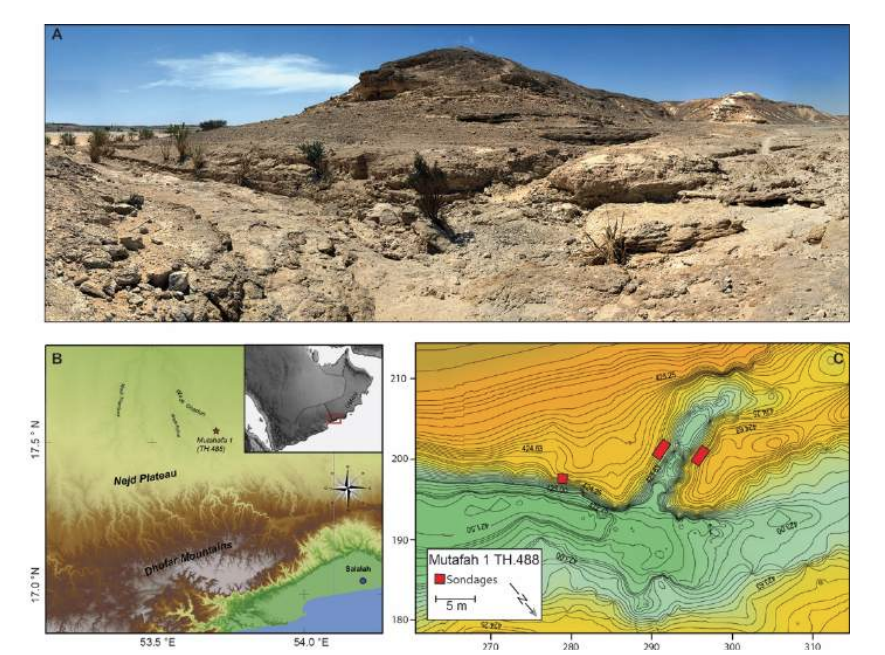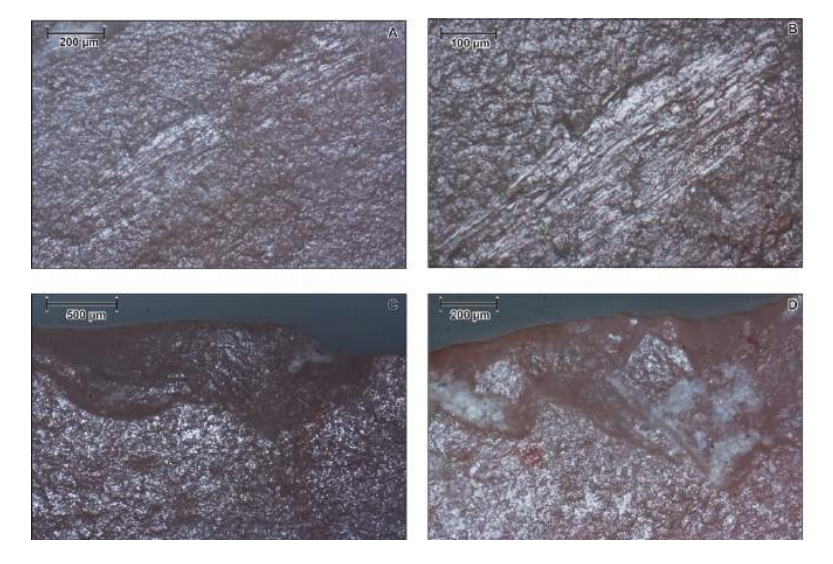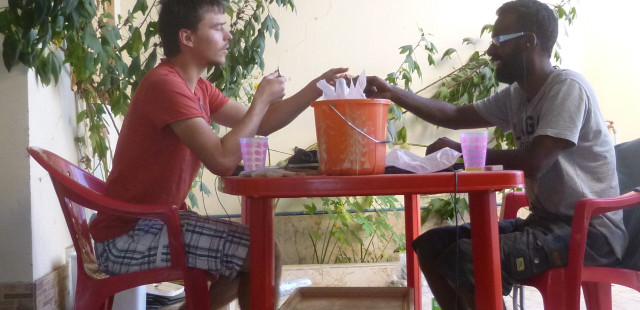Traceological analysis of Paleolithic backed points from Dhofar: insights into South Arabian projectile technology
Yamandú H. Hilbert1, Ignacio Clemente-Conte2, Najat al-Fudhaili3, Matthias López Correa3,4
1) Institut für Ur- und Frühgeschichte, Friedrich-Alexander-Universität Erlangen-Nürnberg, Kochstr 4/18, 91054 Erlangen, Germany
2) Departamento de Arqueología y Antropología, Institución Milá y Fontanals, CSIC, Egipcíaques 15, 08001 Barcelona, Spain
3) GeoZentrum Nordbayern, Universität Erlangen-Nürnberg, Loewenichstr. 28, D-91054 Erlangen, Germany
4) Consiglio Nazionale delle Ricerche, Istituto di Scienze Marine, via Gobetti 101, I-40129 Bologna, Italy
Projectile technology refers to launched weapons propelled by physical strength, that may have its range and speed augmented by mechanical force using specifically developed launching systems (i.a. spear thrower, bow, cross-bow, etc), with the intent to kill or wound a target. The significance of this technology to the evolution of our species, the chrono/cultural variability, geographical distribution as well as the impact it made and still makes on archaeological interpretations are the subjects of many scientific articles and books (Iovita and Sano, 2016; see also Knecht, 1997 and ref. therein). The identification and attribution of a specific artefact to this category, however, may be complicated and given circumstances related to the preservation of archaeological artefacts challenging.
Here, we focus on the stone insets attached to the wooden shaft that serves as the projectile. One of the reasons for focusing on the stone insets is their durability in comparison with most archaeological organic remains. These prehistoric stone insets show great morphological variability throughout the Stone Age (Paleolithic) and reach their absolute peak in display of skill and craftsmanship during the Neolithic. This variability is a result of how points were hafted, shot, weather made from organic and inorganic material, as well as from a vast array of social factors.
In order to reconstruct how Paleolithic stone insets were made and to ascertain their function we made use of the traceological method (e.g. Clemente-Conte, 1997; GonzálezUrquijo and Ibañez-Estéves, 1994; Semenov, 1964), which aims at detecting the micro- and macro-traces of production and use of any given artefact. By scanning the edges and surfaces of the tools under different magnifications (from x1 to x800), macro- and microscopic traces including scars, micro-polished spots, scratches, striations, residues, microscopic impact traces, are plotted on the tool. These observed patters are compared to those of an experimental reference collection and interpreted (Fischer et al., 1984).
The oldest uses of projectiles in South Arabia remain largely understudied. To the north, however, researchers have observed that Levallois points from the Eastern Mediterranean and Northeast Africa show traces suggesting their use as stone insets in thrusting or throwing spears (Rots et al., 2011; Boëda et al., 1999; Plisson and Beyries, 1998; Shea, 1988), providing a glimpse into Middle Palaeolithic (ap. between 200.000 to 40.000 years ago) projectile technology. The use of the Levallois points as part of hunting equipment has also been suggested for the Dhofar Nubian Complex sites found in southern Oman (Rose et al., 2011). The subject is, however, debated and traceological analysis of the points needs to be conducted if the function of these elongated and triangular stone tools is to be determined.
Thanks to the generous support of the International Foundation for the Study of Arabia a traceological study of the backed points from the Upper Palaeolithic site of Mutafah 1 dated to ap. 30,000 years ago was conducted (Figure 1). The site was excavated in 2013 and published in 2019 (Rose et al., 2019). The backed points and the OSL chronology of the site indicate the presence of a human population in South Arabian during a period of aridity (Hilbert et al., 2018; Preusser, 2009). In total, 16 artefacts have been exported from the Sultanate thanks to permits issued by the Ministry of Heritage and Culture of Oman. The analyses were conducted at the microscopy laboratories of the CSIC-IMF in Barcelona and at the University of Erlangen.

Figure 1: View of the Upper Paleolithic Mutafah 1 site (A) in Southern Oman. (B) Location map and (C) detailed topography and sondage positions at Mutafah 1 excavated in 2013 (see Rose et al., 2019).
The majority of the backed pieces (Figure 2) show continuous abrupt retouch from tip to bottom creating a deliberately curved shape; the backing is conducted by direct percussing using a mineral hammerstone. Both the distal and proximal terminations of the artefacts show deliberate traces of shaping by fine direct percussion, forming a bi-pointed arched backed lithic inset. These arched backed bladelets share specific technological and morphological features making it germane to propose comparable operational sequences for the manufacture of these tools.

Figure 2: Characteristic backed points from Mutafah 1. The red marks on artefact #5 shows the position of the identified linear impact traces seen in fig 4 A and B. Marks on artefact #8 show where the micrographs B and D seen in figure 4 have been taken.
Microscopic residues were found attached to the tip of specimen #50 (Figure 3). The residue is characterized by a smooth and highly reflective surface, that shows a specific mudcracked pattern. While it has been argued that such patterns may be distinctive for blood residues an objective determination of residues based primarily on optical characteristics remains unsatisfactory. SEM-EDS analysis of the residues is currently underway.

Figure 3: Residue on a backed point from Mutafah 1. Note the polygonal cracked pattern of the residues surface.
The micro linear impact traces (Moss, 1983) on specimen #104 (Figure 4) points at its use as a projectile and indicates it has been shot, further three specimens show rounding and micro-polish along their backed portion. Such traces are referred to as “G” polish, or hafting wear(Moss, 1987; Rots, 2010), and indicate that the artefacts where mounted transversally to the wooden arrow (or dart), thus making use of the proximal point to serve as a barb.
Spots of undulating, moderately developed micro-polish and associated negative edgerounding caused by abrasion was observed on specimen #111, localized along the cutting edge of the tool may indicate an alternative use of the bi-pointed tools in the processing of a soft and abrasive organic material. Possibly the cutting of hides or the preparation of a carcase for consumption may be some of the activities conducted.

Figure 4: Micrographs of linear impact traces seen on the tip of artefact #104 under 100x (A) and 200x (B). C and D show the traces seen on position 1 and 2 of point #8 in fig.2. Note the edge abrasion of the micro negatives along the ridges and the associated undulating, moderately developed and dull micro polish indicating the contact with a soft but abrasive organic material.
The traceological results of the Mutafah 1 arched backed points show these artefacts to be used in at least two different activities, hafted as projectile points and likely used in hunting as well as in transformative/productive activities, showing them to be part of a mobile toolkit. This versatility in use is also applicable to the Levallois point dilemma, demonstrating how stone tools that look the same and were manufactured with the same specific technical system may present different functional applications.
References
Boëda, E., Geneste, J.M., Griggo, C., Mercier, N., Muhesen, S., Reyss, J.L., Taha, A., Valladas, H., 1999. A Levallois point embedded in the vertebra of a wild ass ( Equus africanus ): hafting, projectiles and Mousterian hunting weapons. Antiquity 73, 394–402.
Clemente-Conte, I., 1997. Los instrumentos líticos del Túnel VII: una aproximación etnoarqueológica, Treballs d’Etnoarqueologia II. C.S.I.C U.A.B., Barcelona. Fischer, A., Hansen, P.V., Rasmussen, P., 1984. Macro and Micro Wear Traces on Lithic Projectile Points Experimental Results and Prehistoric Examples. Journal of Danish Archaeology 3, 19–46.
González-Urquijo, J.E., Ibañez-Estéves, J.J., 1994. Metodología de análise funcional de instruentos tallados en sílex, Cuadernos de Arqueología. Universidad de Duesto, Bilbao. Hilbert, Y.H., Geiling, J.M., Rose, J.I., 2018. Terminal Pleistocene archaeology and archaeogenetics in South Arabia : Evidence from an ice age refugium, in: Purdue, L., Charbonnier, J., Khalidi, L. (Eds.), Vivre En Milieu Aride de La Préhistoire à Aujourd’hui. Presented at the XXXVIIIe rencontres internationales d’archéologie et d’histoire d’Antibes, Éditions APDCA, Antibes, pp. 33–49.
Iovita, R., Sano, K. (Eds.), 2016. Multidisciplinary approaches to the study of Stone Age weaponry, Vertebrate Paleobiology and Paleoanthropology Series. Springer, Dordrecht. Knecht, H., 1997. The History and Development of Projectile Technology Research, in: Knecht, H. (Ed.), Projectile Technology, Interdisciplinary Contributions to Archaeology. Springer US, Boston, MA, pp. 3–35.
Moss, E., 1987. Polish G and the question of hafting, in: La Main et l’outil: Manches et Emmanchements Préhistoriques: Table Ronde CNRS Tenue à Lyon Du 26 Au 29 Novembre 1984. G.S. Maison de l’Orient, Lyon, pp. 97–102.
Moss, E.H., 1983. The functional analysis of flint implements: Pincevent and Pont d’Ambon: two case studies from the French final palaeolithic, BAR International Series. Archaeopress, Oxford.
Plisson, H., Beyries, S., 1998. Pointes ou outils triangulaires ? Données fonctionnelles dans le Moustérien levantin [suivi des] Commentaires de J. Shea, A. Marks, J-M Geneste et de la réponse des auteurs. Paléorient 24, 5–24. https://doi.org/10.3406/paleo.1998.4666
Preusser, F., 2009. Chronology of the impact of Quaternary climate change on continental environments in the Arabian Peninsula. Comptes Rendus Geoscience 341, 621–632. Rose, J.I., Hilbert, Y.H., Usik, V.I., Marks, A.E., Jaboob, M.M.A., Černỳ, V., Crassard, R., Preusser, F., 2019. 30,000-Year-Old Geometric Microliths Reveal Glacial Refugium in Dhofar, Southern Oman. Journal of Paleolithic Archaeology 2, 338–357.
Rose, J.I., Usik, V.I., Marks, A.E., Hilbert, Y.H., Galletti, C.S., Parton, A., Geiling, J.M., Černý, V., Morley, M.W., Roberts, R.G., 2011. The Nubian Complex of Dhofar, Oman: An African Middle Stone Age Industry in Southern Arabia. PLOS ONE 6, e28239.
Rots, V., 2010. Prehension and hafting traces on flint tools: a methodology. Universitaire Pers Leuven, Leuven.
Rots, V., Van Peer, P., Vermeersch, P.M., 2011. Aspects of tool production, use, and hafting in Palaeolithic assemblages from Northeast Africa. Journal of Human Evolution 60, 637–664. Semenov, S.A., 1964. Prehistoric Technology: an Experimental Study of the Oldest Tools and Artifacts from Traces of Manufacture and Wear. Barnes and Noble, New York.
Shea, J.J., 1988. Spear Points from the Middle Paleolithic of the Levant. Journal of Field Archaeology 15, 441–450.




